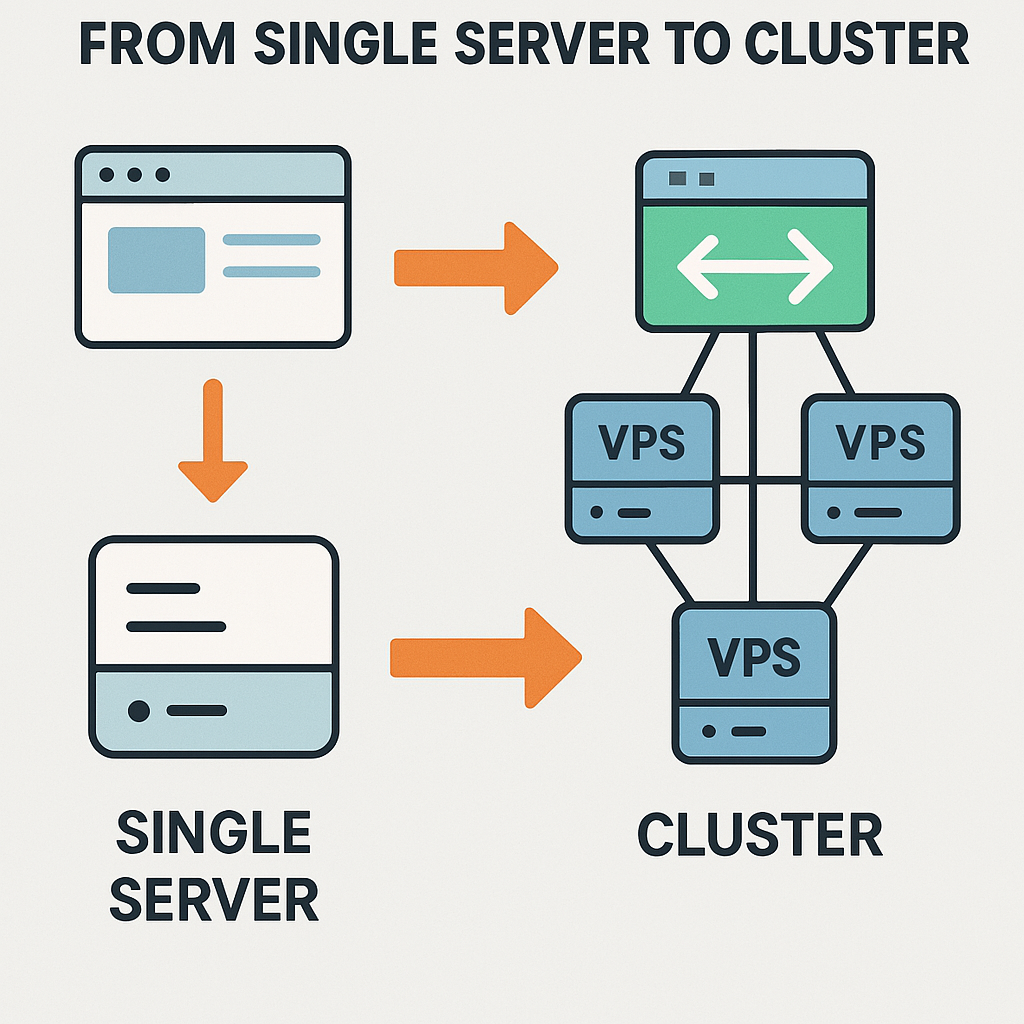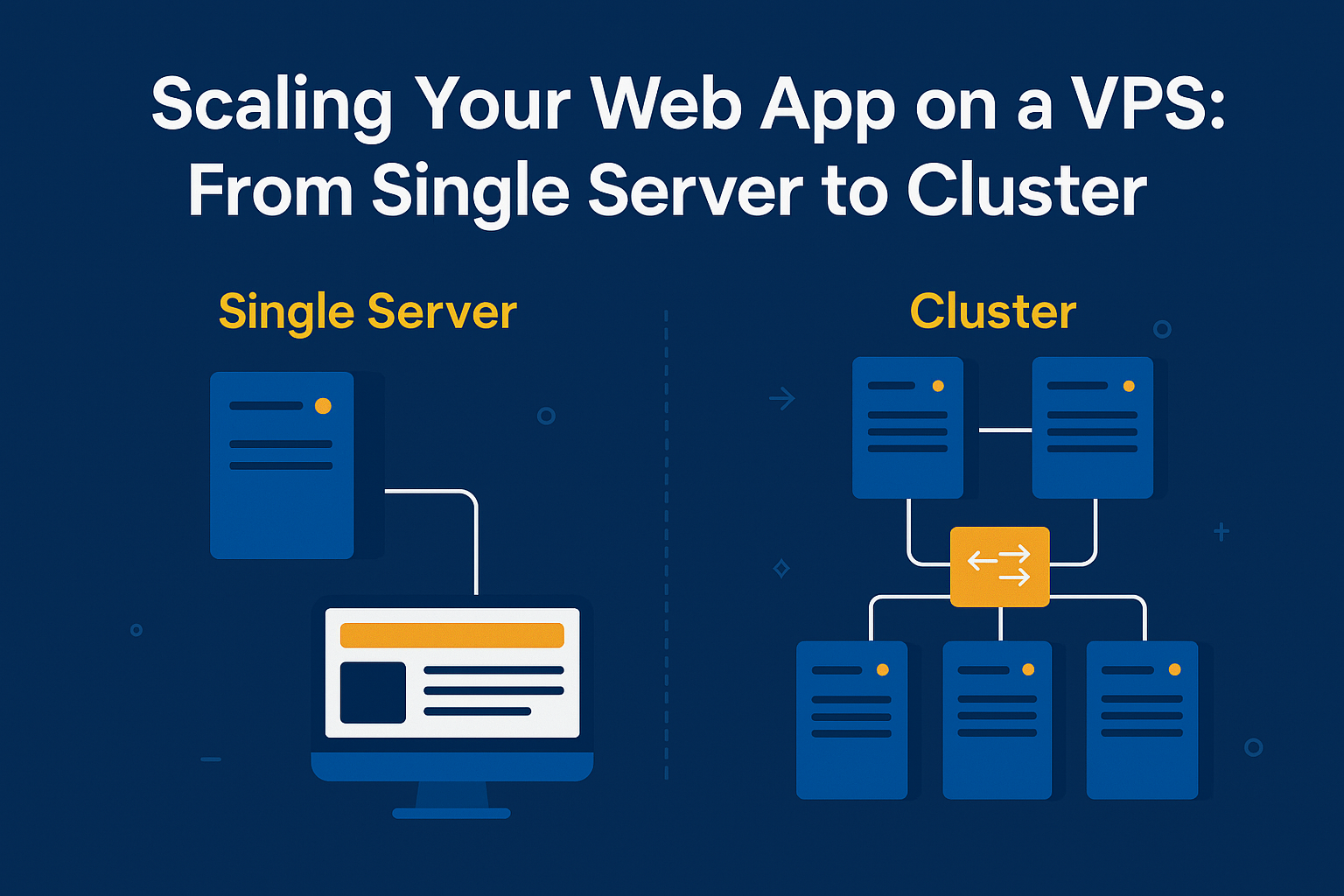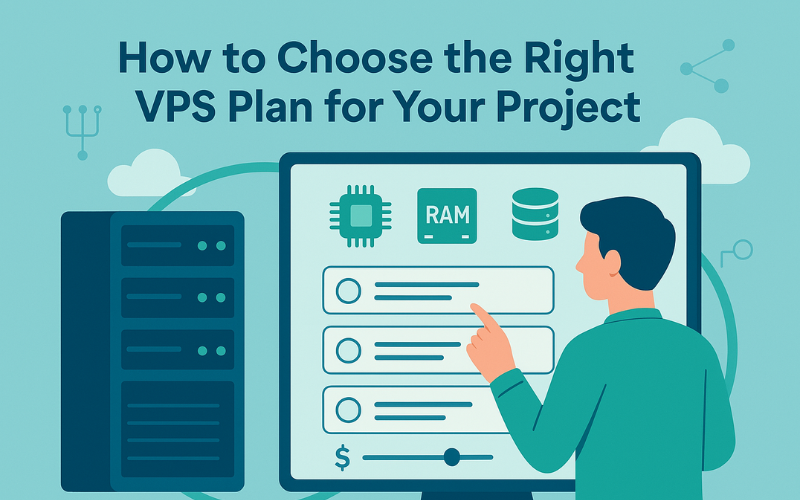
Introduction: Why Scaling Matters
As your web application grows, it’s important to consider scalability. Early on, a single VPS (Virtual Private Server) might suffice, offering a cost-effective and flexible hosting solution. However, as your user base expands, you’ll begin to encounter limitations in terms of performance and reliability. At this point, scaling becomes crucial to ensuring your app can handle the increasing traffic and demand.
In this blog post, we’ll discuss the process of scaling a web app from a single VPS to a more robust VPS cluster. We’ll explore the various steps involved in this transition, the benefits, the challenges, and how to ensure your web app remains high-performing and reliable as it grows.
1. Understanding the Need to Scale
Scaling is the process of enhancing your app’s capacity to handle an increased workload. Initially, a single VPS may work well for smaller apps, but as traffic grows and more users interact with your platform, the server may start to struggle with handling the load. The need for scaling arises when the app begins to exhibit symptoms such as:
Slower response times during peak usage
Frequent downtimes or server crashes
Memory or CPU overloads, causing performance degradation
Growing database complexity, where a single server struggles to keep up with the volume of data
It’s important to monitor these signs early and plan for scaling before performance becomes a major concern for your users.
2. Single VPS: The Starting Point
A single VPS can be the perfect solution for small to medium-sized applications. It provides you with several benefits:
Affordability: Compared to dedicated servers, VPS hosting is more cost-effective, making it a good choice for startups and small businesses.
Control over Configuration: You have the ability to customize the server’s settings to fit the specific needs of your app.
Simplicity: Setting up and maintaining a VPS is easier than managing multiple servers, making it a good starting point.
However, there are limitations to using just a single VPS as your app grows. A single server can become overwhelmed as the traffic increases and the number of users rises. Here are some challenges you may encounter:
Memory and CPU Overload: As your app gets more traffic, the server’s resources will be stretched thin, causing slowdowns and even crashes.
Single Points of Failure: With just one server, if it crashes or goes down, your app becomes unavailable to users, causing potential revenue loss and a bad user experience.
Limited Scalability: A single VPS can only handle so much. Once you hit that limit, you’ll need to consider alternative ways to scale.
3. Signs It’s Time to Scale
When should you start considering scaling your app? Here are some signs to look out for:
Slow Performance: If your app’s response time is consistently slow, especially during high traffic, it’s a clear sign that scaling is needed.
Frequent Server Crashes: Regular crashes or downtime due to high resource consumption indicate that the single server can no longer handle the load.
Growing Database Complexity: As the database expands, a single server might struggle to process large queries or manage the volume of data, leading to slow performance or data inconsistencies.
If you start seeing these issues, it’s time to think about scaling your infrastructure to ensure a smoother and more reliable user experience.
4. VPS Cluster: Transitioning for Growth
When your web app outgrows the capacity of a single server, the next step is to move to a VPS cluster. A cluster involves using multiple servers that work together to handle the load, ensuring that no single server is overwhelmed.
To transition smoothly from a single VPS to a cluster, here are some key steps to consider:
Load Balancing
Load balancing is the process of distributing incoming traffic across multiple servers. This ensures that no one server bears the entire load, helping maintain performance even during traffic spikes. A load balancer helps route requests to the appropriate server, ensuring faster response times.
Database Replication
For a distributed system to work smoothly, it’s essential to replicate the database across multiple servers. Database replication ensures that all servers have the same data, preventing inconsistencies and ensuring that if one server fails, another can take over without disrupting the user experience.
Auto-Scaling
Auto-scaling allows your system to automatically add or remove servers based on demand. If your app experiences a traffic surge, additional servers can be spun up to handle the load. Conversely, if traffic decreases, unnecessary servers can be decommissioned, reducing costs.
Content Delivery Network (CDN)
A CDN helps offload static content (like images, stylesheets, and JavaScript files) from your servers to distributed edge servers closer to the users. This reduces latency and speeds up content delivery, particularly for users located far from your primary server.
Monitoring and Optimization
As you scale, continuous monitoring becomes essential to ensure the system is performing as expected. Use tools like server health monitoring and performance analysis to identify bottlenecks and optimize server configurations, ensuring that resources are being used efficiently.
5. Benefits of a VPS Cluster
Scaling to a VPS cluster offers several significant benefits:
Improved Performance: With multiple servers handling the load, your app can provide faster response times and better user experiences even during high traffic periods.
High Availability: By distributing traffic and data across multiple servers, a clustered setup ensures high availability. If one server fails, others can seamlessly take over, minimizing downtime.
Scalability: As your business grows, you can easily add more servers to your cluster to meet increasing demand. This elasticity allows you to scale as needed without significant upfront investment.
6. Overcoming Common Challenges
Scaling isn’t without its challenges. Some of the most common hurdles include:
Complexity: Managing a VPS cluster requires more technical expertise compared to a single server. You’ll need to set up and maintain load balancers, auto-scaling rules, and database replication, which can add complexity to your infrastructure.
Cost: While a single VPS is affordable, a VPS cluster can be more expensive due to the need for additional servers. However, you can balance this by optimizing resources and using cloud-based VPS solutions that offer scalability without heavy upfront costs.
Data Consistency: Ensuring data consistency across all servers in a cluster can be tricky, particularly with a distributed database. You’ll need to ensure that replication is set up correctly and that all servers are synchronized to avoid issues like data conflicts or inconsistencies.
Conclusion: Continuous Growth and Adaptability
Scaling your web app from a single server to a VPS cluster is an essential step in ensuring your app can handle growing traffic and data. While it involves careful planning and the management of multiple servers, the benefits of increased performance, reliability, and flexibility make it worth the effort.
Remember, scaling is not a one-time task but an ongoing process. As your user base grows, continue to monitor, optimize, and adapt your infrastructure to keep your app running smoothly. Whether you’re just starting out with a single VPS or moving toward a more complex cluster setup, make sure your web app is always ready for the next stage of growth.




